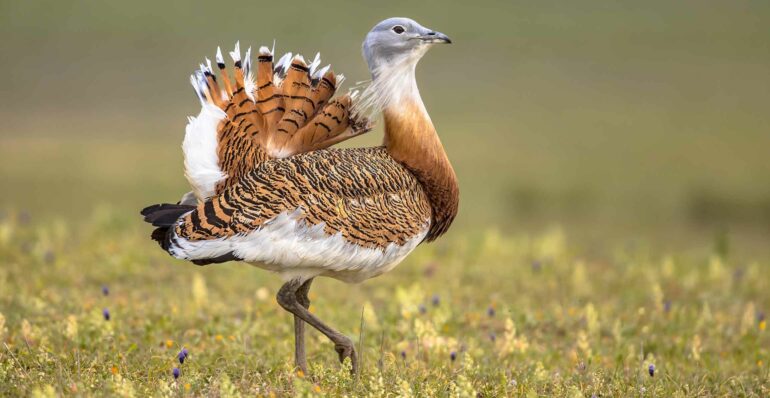The butchered remains of great bustards found in the graves of people buried 15,000 years ago show that these birds had a cultural significance.
The researchers hope that the remains unearthed in Morocco can help bolster the conservation of the critically endangered population of great bustards that still survive in the country.
The oldest cemetery in Africa is yielding yet more insights into the lives of ancient humans.
About 15,000 years ago, people were living and burying their dead in a cave in northern Morocco. On the cusp of the transition between a semi-nomadic and settled life, the remains of these people and their grave goods offer a fascinating insight into the lives and cultures of this community.
Part of this seems to have involved a bird known as the great bustard. These large, impressive animals were once found across much of Eurasia and part of North Africa until hunting, habitat disturbance and destruction significantly fragmented their population.
Africa’s only population clings on in Morocco, where the species is considered critically endangered. Closely related but genetically distinct to the Spanish population, there has been some debate about how long great bustards had lived in North Africa. This new finding confirms that the birds have a long history on the African continent, and were much more abundant and widespread than they are today.
Dr. Joanne Cooper has been studying the great bustard remains found in the human graves to better understand the significance and role these birds played in this ancient culture.
“We see a strong cultural association with the great bustard because the people are not only depositing them in burials, but there’s also evidence that they were eating them as well,” says Dr. Cooper. “We believe that was part of the funeral rites.”
“It seems to be a feasting set-up, which is a very specific type of ritual eating.”
The research has been published in the journal Ibis.
The world’s heaviest flying animal
The great bustard is a large, imposing bird that really lives up to its name. With males reaching weights approaching 20 kilograms, it makes them one of the heaviest flying birds in the world.
A specialist of open grasslands and farmland, the great bustard requires equally massive areas of relatively undisturbed land to live and breed on. This typically occurs in March, when the normally well-camouflaged males reveal themselves in elaborate displays and violent fights as they compete for female attention in an area known as a lek.
With the spread of humans and agricultural intensification, the birds have been significantly impacted. Already highly vulnerable to human disturbance, they have also historically been targeted by hunters both as a food source and a trophy. The combined effects of human activities have resulted in rapid declines and extinctions of populations across much of the species’ former range, with over half the population now restricted to Spain.
In northwestern Morocco about 70 birds survive, living in two small areas. Although known to be different from the Iberian population, there have long been questions about the origins of these great bustards. Some, for example, have suggested that they are a relatively recent addition to the Moroccan birdlife, having flown over from Spain in historical times.
But Dr. Cooper’s work in the Taforalt cave in eastern Morocco is showing that great bustards actually have a long history in the country. What’s more, they seemingly played an important cultural role in the lives of the ancient people who lived there.
Taforalt cave, also called Grotte des Pigeons, is a globally important site. It contains the graves of more than 30 ancient humans thought to have been buried 14,700 years ago. At this point in time, mammoths still grazed the northern steppes and sheep were yet to be domesticated.
The environmental conditions of the cave mean that not only have the bones and tools of these early people been preserved, but also a huge range of other biological material that is allowing researchers like Dr. Cooper and her colleagues to build an amazingly detailed picture of their lives. For example, earlier work has found evidence that these people were burning and consuming the medicinal plant Ephedra, alongside other foods such as acorns and juniper.
They were also burying their dead alongside the remains of other animals.
Discover the latest in science, tech, and space with over 100,000 subscribers who rely on Phys.org for daily insights.
Sign up for our free newsletter and get updates on breakthroughs,
innovations, and research that matter—daily or weekly.
Ritual feasting
The most high-status graves have been found to contain the bones of animals which have been butchered and cooked. Some contain the skulls of wild sheep, while one specific burial has the breastbone a great bustard with cut marks, evidence of a meal similar to the turkey crown that many of us eat on Christmas Day.
The repeated presence of great bustard remains in these graves suggests that there was some cultural significance of the bird. This is because it would have taken a lot of time and effort for these people to catch and prepare the animals, which suggests this behavior was not just routine eating, but ritual feasting.
“This is a communal behavior that involves special foods that people have to go out of their way for that is then consumed in some kind of special context,” explains Dr. Cooper. “The habitat for the great bustard isn’t really the kind of mountainous area around the cave in which the remains are found.”
“They would have had to trek down to the plains to catch the bustards, carry them back up to the cave, prepare them, cook them and eat them. The special context is that they’re associated with these burials.”
Dr. Cooper and the research team hope that the discovery of the remains of great bustards dating back so far will help to spur action to protect those birds that still survive in Morocco today. As a critically endangered population, they need more help now than ever to prevent them going extinct in Africa.
More information:
Joanne H. Cooper et al, Late Pleistocene Great Bustards Otis tarda from the Maghreb, eastern Morocco, Ibis (2025). DOI: 10.1111/ibi.13404
Provided by
Natural History Museum
This story is republished courtesy of Natural History Museum. Read the original story here.
Citation:
Ancient humans ritually feasted on great bustards as they buried their dead (2025, April 17)



